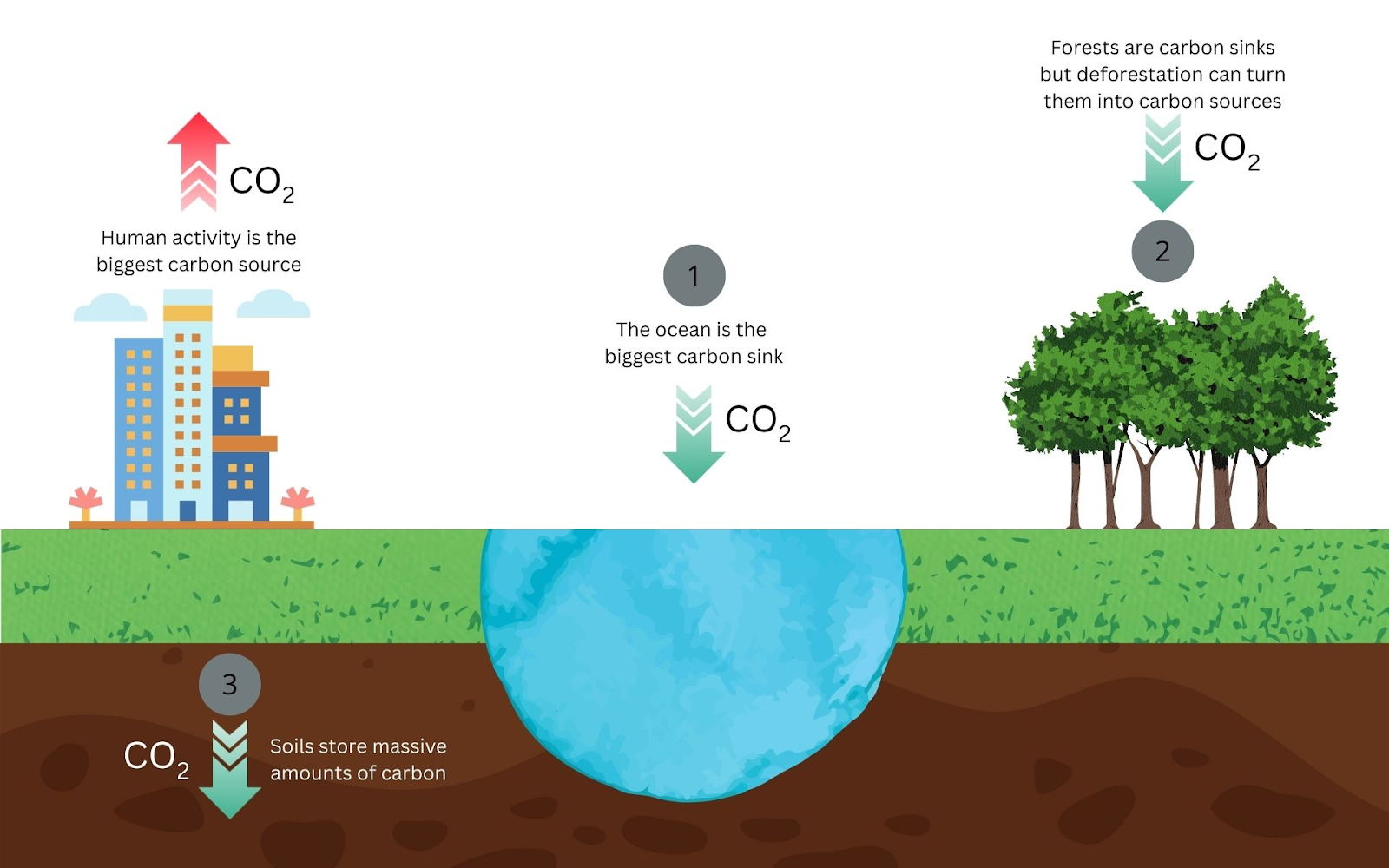Facts for UPSC Mains
Australia’s Northern Rainforests Become Carbon Source
- 24 Oct 2025
- 7 min read
Why in News?
A study published in Nature has found that the tropical forests in northeastern Australia are the first globally to shift from being a carbon sink to a net carbon source.
- This reversal is driven mainly by increased tree mortality due to climate stressors, including cyclones, which can reduce carbon storage for up to 6 years.
- Key climate extremes causing this include rising temperatures, atmospheric dryness, and drought conditions. This highlights how climate change can threaten global carbon budgets.
What is a Carbon Sink?
- About: A carbon sink is anything that absorbs more carbon from the atmosphere than it releases.
- It acts like a natural or artificial reservoir that soaks up and stores carbon dioxide (CO₂), a primary greenhouse gas, thereby mitigating climate change.
- Key Examples:
- Forests: Through photosynthesis, trees and plants absorb CO₂ and store the carbon in their wood, roots, leaves, and soil.
- Oceans: The ocean is the largest active carbon sink. It absorbs CO₂ directly from the air, and marine organisms (like phytoplankton) use it for photosynthesis.
- Soil & Peatlands: Soils contain vast amounts of carbon stored in organic matter from decomposed plants and animals.
What is a Carbon Source?
- About: The opposite of a sink is a carbon source. This is anything that releases more carbon into the atmosphere than it absorbs.
- Key Examples:
- Natural Carbon Sources
- Respiration: Animals, plants, and microorganisms release CO₂ during cellular respiration.
- Volcanic Eruptions: Emit large amounts of CO₂ and methane from beneath the Earth’s crust.
- Wildfires: Burning of vegetation releases stored carbon into the atmosphere.
- Ocean Release: Warmer oceans release dissolved CO₂ back into the air.
- Soil Decomposition: Microbial activity in soil releases carbon as organic matter breaks down.
- Human-Induced (Anthropogenic) Carbon Sources
- Fossil Fuel Combustion: Burning coal, oil, and natural gas for electricity, transport, and industry.
- Deforestation and Land-Use Change: Reduces carbon absorption and releases stored carbon from vegetation.
- Industrial Processes: Cement production, steel manufacturing, and chemical industries emit CO₂.
- Agriculture: Livestock produce methane (CH₄); paddy fields and fertilizers add nitrous oxide (N₂O).
- Waste Management: Landfills and waste incineration release methane and carbon dioxide.
- Natural Carbon Sources
What are the Consequences of Forests Turning into a Carbon Source and Measures Needed for its Mitigation?
|
Consequences |
Measures Needed |
|
Vicious Feedback Loop: Climate change damages forests, causing tree death and carbon release, which further intensifies climate change via more fires and droughts. |
Aggressive Global Emission Cuts: Prioritize deep, rapid, and sustained reductions in fossil fuel emissions and strictly implement enhanced carbon budgets under the Paris Agreement. |
|
Social and Cultural Impacts: Degradation threatens the livelihoods, food, medicine, and culture of Indigenous communities, risking displacement and conflict. |
Proactive Forest Management: Implement large-scale strategies like assisted species migration, controlled burns for fuel reduction, and integrated pest management to break the cycle of dieback. |
|
Ecosystem Collapse: Biodiversity loss and extinction risk as forest degradation and a changing climate make areas unsuitable for native species. |
Climate-Adaptive Policies: Invest in water-efficient irrigation, promote drought-resistant crops, diversify rural economies, and strengthen public health systems. |
|
Impacts on Human Systems: Endangers water security, agriculture, and food production; causes economic losses and increases public health risks. |
Empowerment of Local Communities: Integrate Indigenous knowledge into forest governance, secure land tenure rights, and ensure their active participation in sustainable management. |
Conclusion
The shift of forests from carbon sinks to sources signals a critical climate tipping point, creating a vicious feedback loop that accelerates global warming, demanding urgent emission cuts, forest management, and community action.\
|
Drishti Mains Question: Q. What are carbon sinks and carbon sources? Examine the consequences of the transformation of forest ecosystems from sinks to sources and suggest a framework for its mitigation. |
Frequently Asked Questions (FAQs)
1. What is a carbon sink?
A carbon sink absorbs more CO₂ from the atmosphere than it releases, helping mitigate climate change. Examples include forests, oceans, and soils.
2. What is a carbon source?
A carbon source releases more CO₂ into the atmosphere than it absorbs, contributing to climate change. Examples include fossil fuel burning, wildfires, and deforestation.
3. What are the primary causes of the forest transition from sink to source?
Increased tree mortality due to rising temperatures, droughts, atmospheric dryness (VPD), and cyclones.
UPSC Civil Services Examination, Previous Year Questions (PYQs)
Prelims
Q1. Consider the following agricultural practices: (2012)
- Contour bunding
- Relay cropping
- Zero tillage
In the context of global climate change, which of the above helps/help in carbon sequestration/storage in the soil?
(a) 1 and 2 only
(b) 3 only
(c) 1, 2 and 3
(d) None of them
Ans: (b)
Q2. In the context of mitigating the impending global warming due to anthropogenic emissions of carbon dioxide, which of the following can be the potential sites for carbon sequestration? (2017)
- Abandoned and uneconomic coal seams
- Depleted oil and gas reservoirs
- Subterranean deep saline formations
Select the correct answer using the code given below:
(a) 1 and 2 only
(b) 3 only
(c) 1 and 3 only
(d) 1, 2 and 3
Ans: (d)







